The Apple iPhone 6s and iPhone 6s Plus Review
by Ryan Smith & Joshua Ho on November 2, 2015 8:00 AM EST- Posted in
- Smartphones
- Apple
- Mobile
- SoCs
- iPhone 6s
- iPhone 6s Plus
System Performance
One of the more popular and pervasive beliefs in this industry is that specs increasingly don’t matter. In a lot of ways, this review isn’t really the right place to address whether or not this matters, but the short answer is that things like SoC performance matter quite a bit. Outside of the display, the SoC and RF subsystems are one of the biggest power consumers in a phone today and unlike the display or RF systems the CPU and GPU can cause short spikes of enormous power consumption. At this point, we’ve seen SoCs this year that consume anywhere between 6 to over 12 watts when faced with a full load situation. The important part here is that when an SoC uses that much power, it needs to be delivering enough performance to justify the power consumption. In order to test aspects of the phone like the SoC we use our standard suite of benchmarks, which are designed to test various real-world scenarios to get an idea of what peak performance looks like.
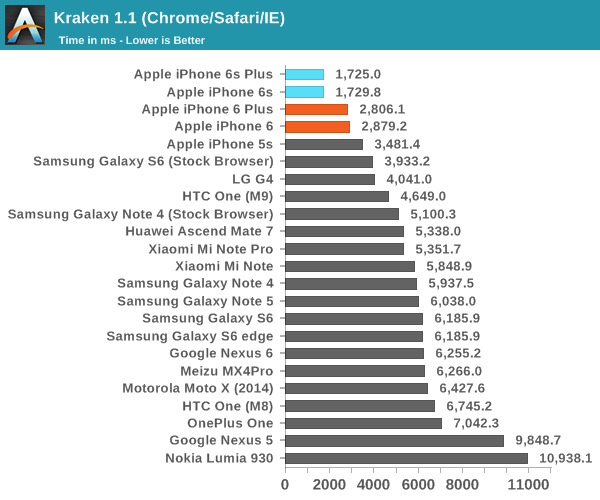
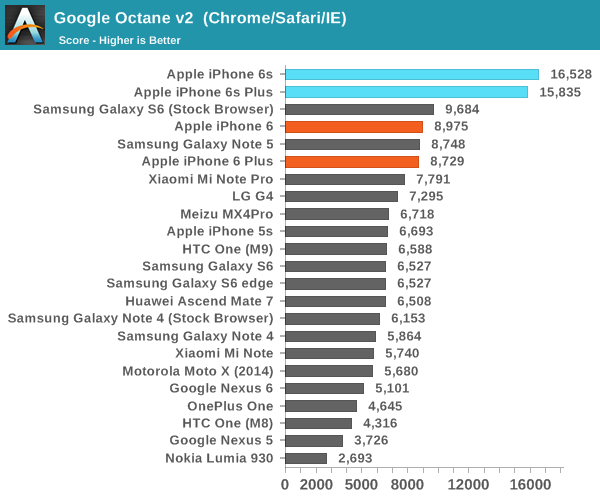
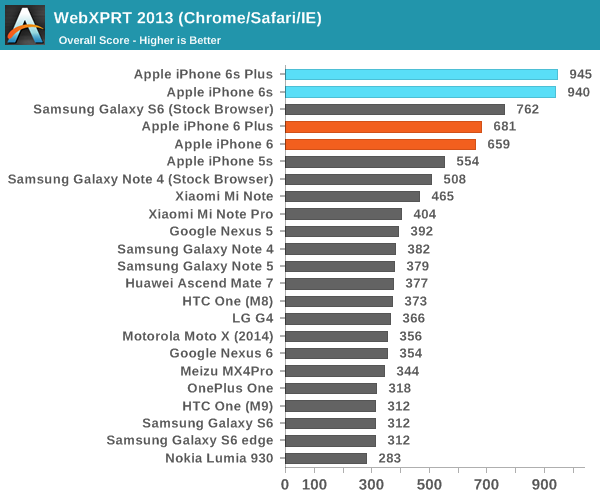
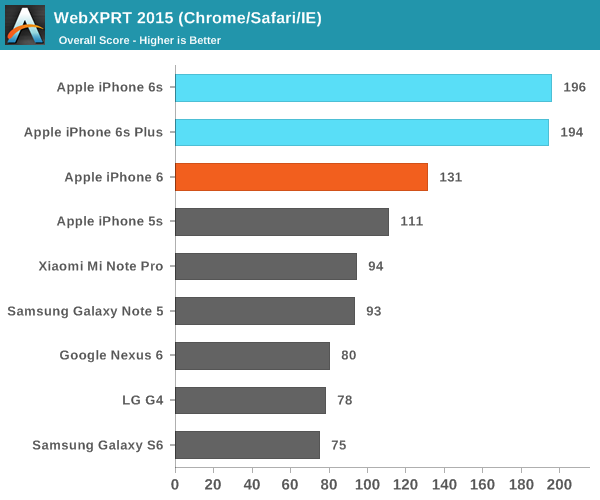
In the standard web browser benchmarks, the iPhone 6s and iPhone 6s Plus are clearly in the lead. The difference in some cases is significant, but given that the benchmarks that we’re running here are all enormous optimization targets it's still a reasonable comparison point. In the interest of trying to avoid optimization targets I decided to look at some new JavaScript benchmarks that aren’t regularly used right now. One interesting benchmark is Ember Performance, which is a JavaScript app framework that is used in a number of popular websites and applications. This isn’t as popular as AngularJS at the moment, but in the absence of a good mobile benchmark EmberJS should be a reasonably good proxy.
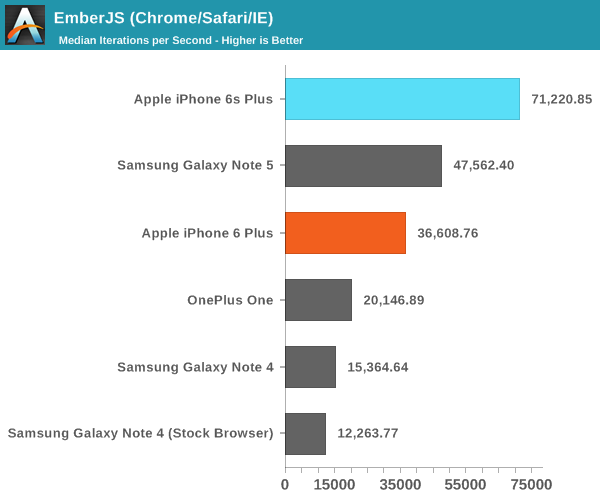
In this benchmark, we can see that there’s a pretty enormous performance uplift that results when you compare the iPhone 6s' to anything else out there on the market. Weirdly enough, on average it looks like Samsung’s S-Browser ends up slower here than Chrome, but it’s likely that this is just because S-Browser is using an older build of Chromium which negates the advantages of platform-specific optimizations that Samsung is integrating into S-Browser.

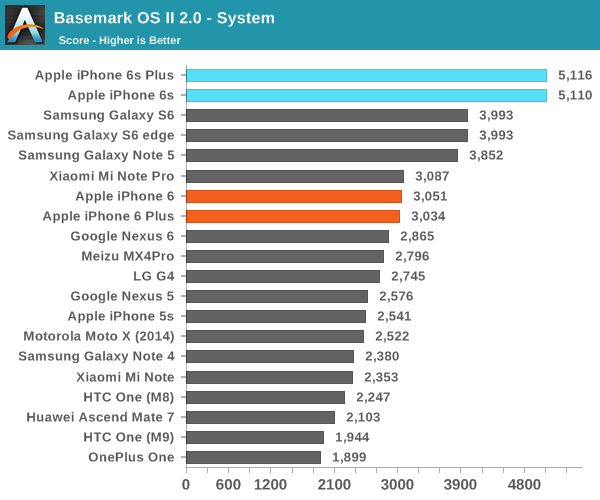
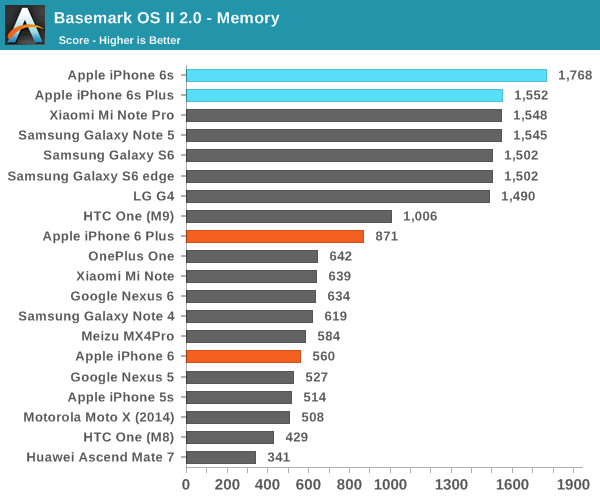
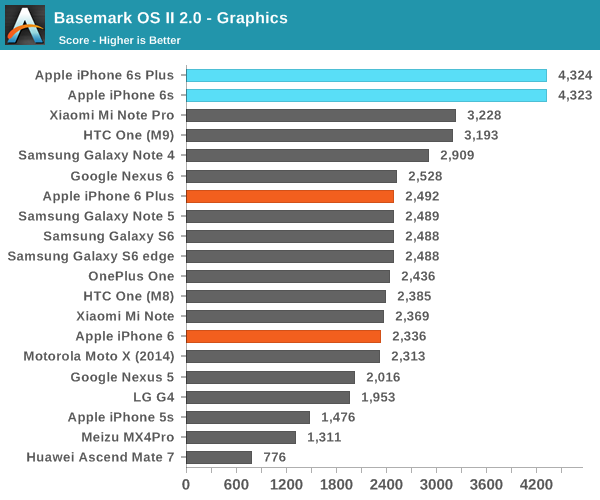
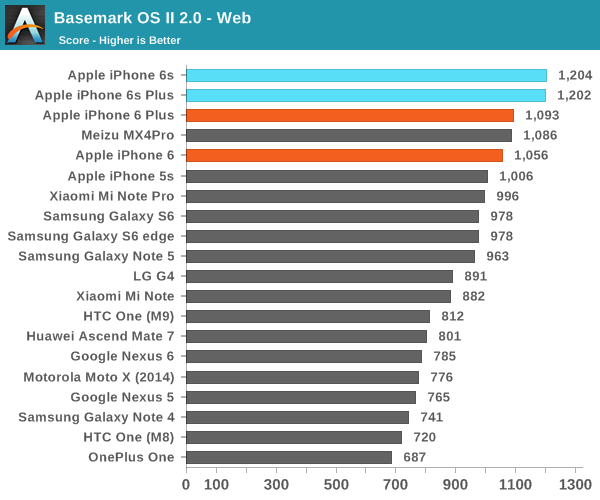
Looking at Basemark OS II, once again Apple is basically taking the lead across the board. The differences aren’t necessarily as enormous as they are in single-threaded browser benchmarks, but the iPhone 6s’ retain a significant overall performance lead over the next best mobile devices.
Overall, in benchmarks where CPU performance is a significant influence the iPhone 6s is pretty much at the very top of the stack. Of course, Apple has also had about 6-8 months of time since the launch of SoCs like the Snapdragon 810 and Exynos 7420 so this is at least partially to be expected. The real surprise and/or disappointment would be if future Exynos and Snapdragon SoCs continue to lag behind the A9 in CPU performance.










531 Comments
View All Comments
zeeBomb - Thursday, November 12, 2015 - link
Let's go to 515!Rdmkr - Tuesday, November 17, 2015 - link
Every time I try to take these phones seriously I take one look at those barren 2010 size bezels and - sorry - my stomach contents just start to surface. And what about that brick-like near 200 grams weight of the 6s plus. Androids would never get away with such design transgressions but here nobody bats an eye.fl0w3n - Saturday, November 21, 2015 - link
what caused the significant jump in the iPhone 6 and 6 Plus bench results versus the ones posted in previous reviews?Miller1331 - Tuesday, December 1, 2015 - link
Cue the apple fanboys..xCyborg - Thursday, December 3, 2015 - link
About that Mobile SoC GPU Comparison, I still don't understand how we're still hovering around 115GFlops after all those years. Isn't the A8X supposed to hit 300GFlops? so the GT7600 should be around that number!I noticed a pattern with GPUs, each year their theoritical performance is reviewed to the lower. Weird.
Goyim - Monday, December 7, 2015 - link
In which Country is the iPhone manufactured?Goyim - Monday, December 7, 2015 - link
Are there any phones made in America?kaeze - Sunday, December 27, 2015 - link
Could you help share the Nand performance testing tool? I also want to test my IPhone 6s. I try to Google it, but I can't find anything.someone_youknow - Sunday, February 14, 2016 - link
The memory latency charts show off the various cache hierarchy levels but the L1 (Data Cache) is hard to read. Does anyone know what the latency is?13nBLdkL5uPmowc - Tuesday, August 16, 2016 - link
The only big problem with android phones, windows phones, and all other smart-phones in the entire smartphone-industry in general is that their touchscreens do not compete in any way with Apple their "high-tech" and "advanced-interactive" and "intuitive-smooth-control".The high-frequency of interaction en nearly gapless response when using the iPhone/iPad or any other iOS powered devices is a tremendous advantage, when accuracy of the touchscreen is necessary for fast and gapless interaction. NO OTHER COMPANY DOES INCLUDE TOUCHSCREENS LIKE THEIRS, AND EVEN SOME HIGH-CLASS SMARTPHONES THAT COME CLOSE COST THE SAME OR EVEN MORE!!! Posted on Wednesday 17th of August 2016!!!